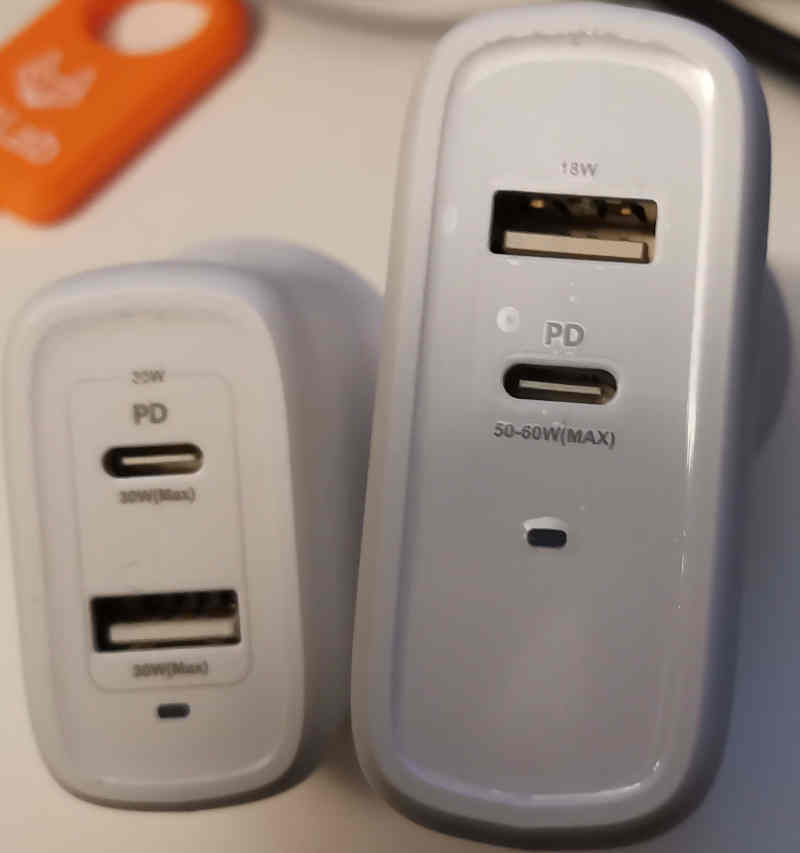A recent development is cheap Gallium Nitride based power supplies that provide better efficiency in a smaller space than other technologies. Kogan recently had a special on such devices so I decided to try them out with my new Thinkpad X1 Carbon Gen 5 [1]. Google searches for power supplies for that Thinkpad included results for 30W PSUs which implies that any 30W USB-C PSU should work.
I bought a 30W charger for $10 that can supply 15V/2A or 20V/1.5A on a single USB-C port or 15W on the USB-C port and 15W on the USB-2 port at the same time and expected it to work as a laptop charger. Unfortunately it didn’t, I don’t know whether the adverts for 30W Thinkpad PSUs were false or whether the claim of the GaN charger I bought being 30W was false, all I know is that the KDE power applet said that the PSU couldn’t supply enough power.
I then bought a 68W charger for $28 that can supply 20.0V/3.0A on a single USB-C port if the USB-2 port isn’t used and 50W on the USB-C port if the USB-2 port is also being used. This worked well which wasn’t a great surprise as I had previously run the laptop on 45W PSUs. If I connect a phone to the USB-2 port while the laptop is being charged then the laptop will be briefly cut off, presumably the voltage and current are being renegotiated when that happens.
As you can see the 68W charger is significantly larger than the 30W charger, but still small enough to easily fit in a jacket pocket and smaller than a regular laptop charger. One of my uses for this will be to put it in a jacket pocket when I have my laptop in another pocket. Another use will be for charging in my car as the cables from the inverter to convert 12VDC to 240VAC takes enough space. I will probably get a ~50W USB-PD charger that connects to a car cigarette lighter socket when a GaN version of such a charger becomes available.


Lowest Wattage USB-C charger that Lenovo sells is 45W.
I think it pretty safe to assume that 45W is the minimum you need for it to charge.
https://support.lenovo.com/us/en/solutions/pd014168-ac-dc-and-acdc-power-adapter-charger-reference-guide
I’m using a small Lenovo 45W charger and I also have one no-name USB-C PD 45W charger that also works fine with my T480s Thinkpad.
https://pcsupport.lenovo.com/us/en/accessorieslookup?partid=40AW0045EU
I’ve got a phone charger that states ‘Max 20W’, and it successfully charges (slowly) a Lenovo Thinkpad E15 (gen2) and a Dell Inspiron.
On Saturday, 10 December 2022 09:04:24 AEDT a Linux programmer I know wrote:
> For my T14s Gen3 I had good results with Anker 45W chargers, but I see
> that the charging light also turns on with my Googlephone 18W/9V
> charger.
> A plain 5V charger does not work at all.
> I suspect that newer laptops accept a much wider range of voltages.
Right now my laptop says that the battery discharge rate is 12.2W so there’s no technical reason why it couldn’t at least run on a 18W charger. It’s not surprising that newer laptops do things better in this regard.
The T14s has nice specs, I had previously ruled out the T series because I now like laptops smaller than what the T series used to be, but the T14s is between the X1 Carbon Gen 1 and Gen 5 in size and mass. So it’s something to consider for the future. However my current Thinkpad should last many years if I don’t drop it and my previous one is still quite usable apart from the annoying lack of USB-C and high resolution.
Arti: There are reports of Thinkpads of different model than mine charging from smaller chargers. For the form factor of typical laptop chargers it wouldn’t make much sense to do less than 45W, no-one would want to carry that much mass and volume for less power. But charging from phone chargers is a good feature.
It’s nice to know that the $10 I spent on a 30W charger wasn’t wasted, I can probably charge some future laptop with it. Also if I’m lucky Lenovo will release a BIOS update to allow the current one to charge with a lower capacity charger.